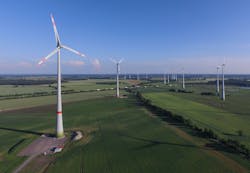Last week, Newsweek, in partnership with Corporate Knights ranked the world’s largest companies on corporate sustainability and environmental impact.
Here are the Top 10 in US:
Allergan
The company’s solar panel-based electricity generating system that it installed at its Irvine, Calif. headquarters was cited as one reason for the top ranking. This solar system helped the company reduce its total energy consumption by 11% on a per square meter basis from 2011 to 2012.
Adobe Systems
The company uses Windspire wind turbines and Bloom Energy fuel cells to help power several of its California facilities. Additionally 70% of the square footage of the company’s global building footprint (including its San Jose, Calif.) is certified by LEED, the world’s pre-eminent set of green building standards.
Ball Corp.
The company invested $18.5 million in energy savings projects in 2012 and 2013, resulting in annual electricity savings of more than 51 million kilowatt hours and natural gas savings of approximately 110 million kilowatt hours.
Ecolab
A program the company calls “Create and Maintain Value,” which identifies ways to make water, energy and wastewater management more efficient, is being systematically rolled out across its global facilities. The company’s Clearing, Ill. plant saved 1.5 million kilowatt hours of electricity, 33.5 million BTUs of natural gas and 59.3 million gallons of water annually under this program.
Sigma-Aldrich
Under its “Air to Ocean” project, which began in 2013, the company increased its volume of ocean freight from 200 tons in 2011 to 350 tons in 2012, resulting in a reduction of carbon emissions by over 700 tons.
McCormick
The company’s 368,000-square-foot distribution center in Belcamp, Md., recently achieved “net zero status,” which means it generates as much or more electricity than it consumes each year. It was the first such building in Maryland and one of only a few in the country.
Biogen Idec
The company has programs that create energy out of waste, including incineration, which converts solid waste into energy by combusting organic material. It also implements projects to compost wastewater byproducts. For example, a project at the company’s Hillerød facility in Sweden converted 180 tons of ammonium sulfate solution into fertilizer in 2012.
Rockwell Automation
Rockwell is focused on improving energy efficiency through improvements to heating, cooling and lighting systems. The company’s 2.1 million-square-foot corporate headquarters in Milwaukee earned LEED certification in 2012, making it the eighth-largest LEED-certified building in the U.S.
Cardinal Health
In 2010, the company converted the material that it uses to package its surgical gloves into recyclable paper, which reduces Cardinal’s overall material use by 1.2 million pounds per year.A company-wide recycling program reduced Cardinal’s total waste volume by 60% in 2010.
Agilent Technologies
Last year the company started 75 energy conservation projects that collectively reduce its greenhouse gas emission by 5%. As one example, a new humidification system installed at Agilent’s Waldbronn facility in Germany is expected to save the company 228,165 kilowatt hours of energy and 3,900 gallons of water each year. Through a variety of waste management programs, Agilent reduced the amount of solid waste from its manufacturing sites by 80% in 2013.
About the Author

Adrienne Selko
Senior Editor - MH&L, IW, & EHS Today
Adrienne Selko has written about many topics over the 17 years she has been with Endeavor Business Media and currently focuses on workforce development strategies. Previously Adrienne was in corporate communications at a medical manufacturing company as well as a large regional bank.
She is the author of Do I Have to Wear Garlic Around My Neck? which made the Cleveland Plain Dealer's best sellers list. She is a senior editor at Material Handling & Logistics, EHS Today, and IndustryWeek.
Editorial Mission Statement:
Manufacturing is the enviable position of creating products, processes, and policies that solve the world’s problems. When the industry stepped up to manufacture what was necessary to combat the pandemic, it revealed its true nature. My goal is to showcase the sector’s ability to address a broad range of workforce issues including technology, training, diversity & inclusion, with a goal of enticing future generations to join this amazing sector.
Why I Find Manufacturing Interesting:
On my first day working for a company that made medical equipment such as MRIs, I toured the plant floor. On every wall was a photo of a person, mostly children. I asked my supervisor why this was the case and he said that the work we do at this company has saved these people’s lives. “We never forget how important our work is and everyone’s contribution to that.” From that moment on I was hooked on manufacturing.
I have talked with many people in this field who have transformed their own career development to assist others. For example, companies are hiring those with disabilities, those previously incarcerated, and other talent pools that have been underutilized. I have talked with leaders who have brought out the best in their workforce, as well as employees doing their best work while doing good for the world.
